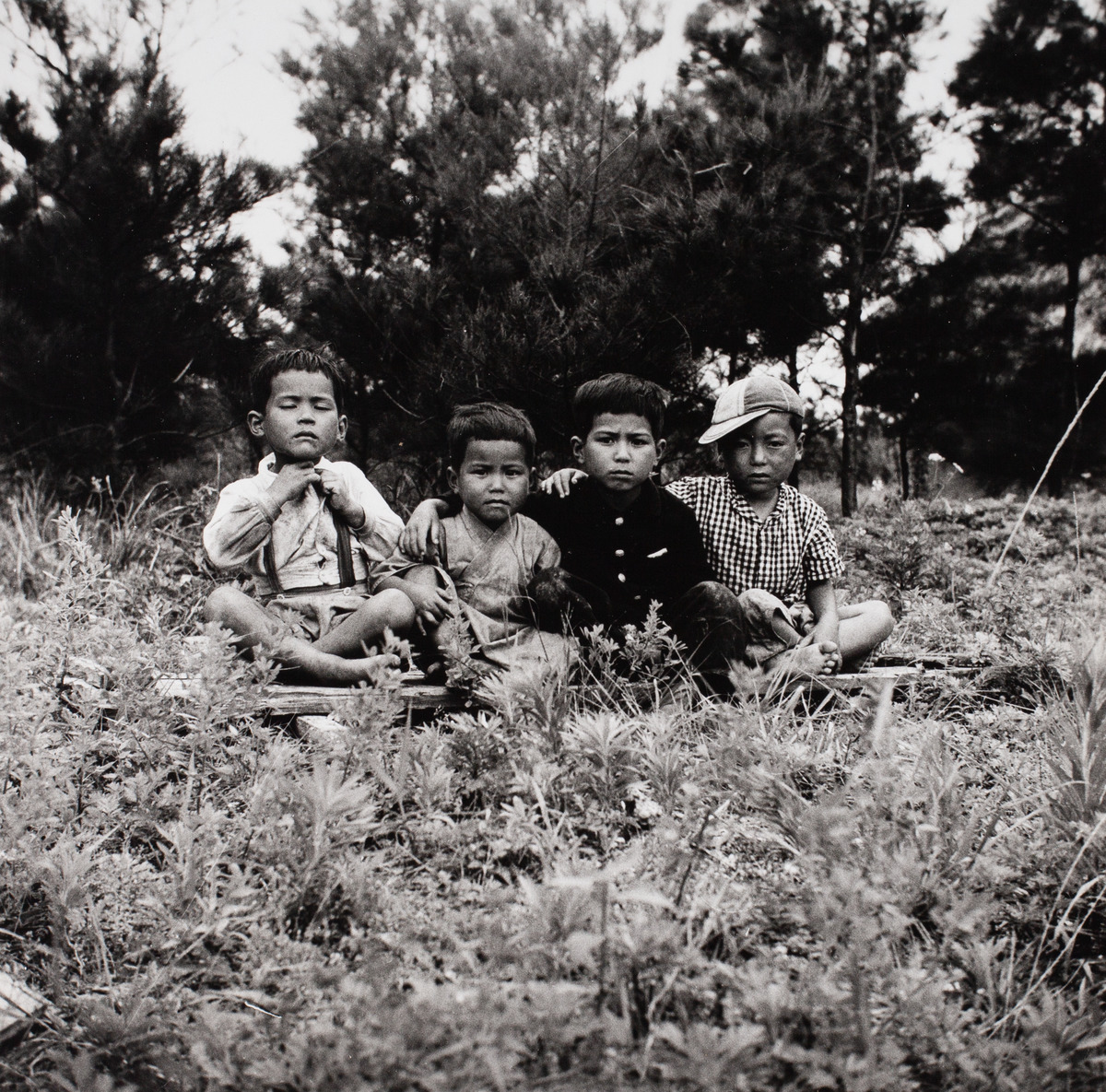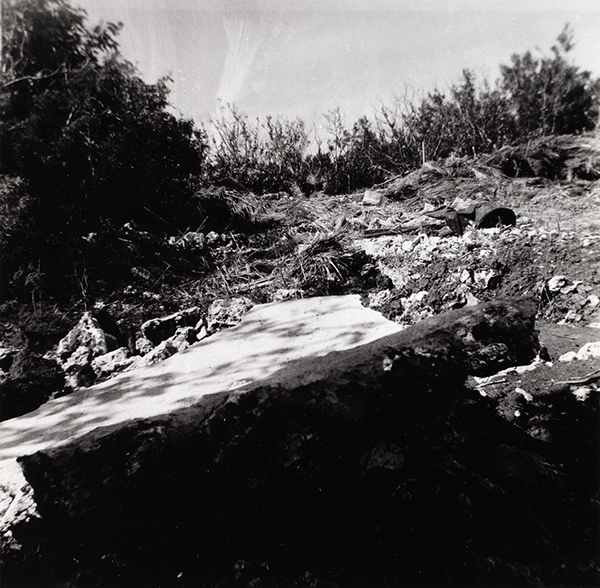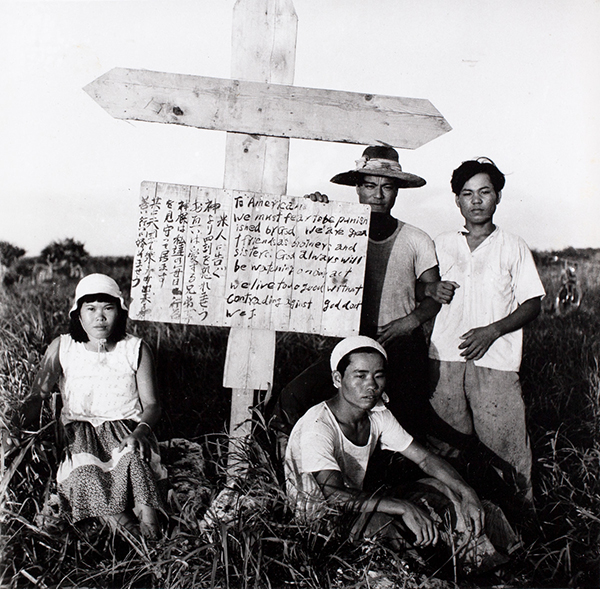
「子供たち」1955 年

「阿波根昌鴻家跡」1955年

「演習地・十字架の看板を立てて訴える若者」1955年
展覧会概要
阿波根昌鴻(1901-2002)は、 沖縄・伊江島で米軍に対して非暴力の土地闘争を展開した人物として知られています。沖縄戦から10年後の1955年、伊江島では基地拡大を目的とした米軍により、阿波根らの住む真謝区の住民らは住む場所と農地を奪われ、餓死者を出すに至りました。「銃剣とブルドーザー」と呼ばれる強制的な土地接収とその後も続いた横暴に対峙するために、阿波根は一台の二眼レフカメラで日々の出来事を記録し始めました。カメラによる記録を抵抗の手段としたのです。阿波根らは島でたった一台しかなかったそのカメラを代わる代わる使い、軍事演習が引き起こす被害や米兵による暴力、「乞食行進」と呼ばれる行脚の様子などを記録し、米占領下で不可視化されていた離島の出来事を可視化しました。やがて支援の輪は、沖縄島だけでなく沖縄と切り離されていた本土にも広がっていきます。
阿波根の著書には、『米軍と農民』(1973年)や『命こそ宝 沖縄反戦の心』(1992年)、唯一の写真集『人間の住んでいる島』(1983年)などがあり、カメラとペンによる詳細な記録が残されています。2002年に亡くなるまで平和の大切さを訴え続けた阿波根は、いつしか「沖縄のガンジー」と呼ばれるようになりました。
東京工芸大学では、『人間の住んでいる島』の編集を手がけた張ヶ谷弘司氏のもとで保存されていたプリントを収蔵すると同時に、残されたモノクロネガフィルム約3,200枚をデジタル化し、新たに銀塩プリントを制作しました。ネガの中には、伊江島の日常のスナップや住民たちのポートレイトが数多く含まれており、阿波根が守りたかったものが何だったのかを垣間見させてくれます。写真史的にも稀有な記録をぜひご覧ください。
(企画構成 小原真史)
阿波根 昌鴻(あはごん しょうこう,1901−2002)
沖縄県上本部村(現本部町)生まれ。農業移民としてキューバやペルーに渡り、1934年に帰国。雑貨店経営の傍ら農民学校の開校を目指して土地を買い求めるが、戦争と戦後の土地接収により中断。1955年からは伊江島住民を率いて土地闘争を始め、のちの「島ぐるみ土地闘争」への端緒を開く。1984年、「反戦平和資料館ヌチドゥタカラの家」「やすらぎの家」からなる「わびあいの里」を設立。著書に『米軍と農民』(岩波新書、1973年)、『人間の住んでいる島』(私家版、1983年)、『命こそ宝 沖縄反戦の心』(岩波新書、1992年)がある。1994年、沖縄県功労賞を受賞。2024年、「写真と抵抗、そして島の人々」展(原爆の図・丸木美術館)でさがみはら写真賞を受賞。
基本情報
| 会期 | 2024年11月5日(火)~ 2025年1月31日(金) |
|---|---|
| 開館時間 | 10:00〜19:00 |
| 休館日 | 木曜日、日曜日、祝日 2024年12月26日(木)〜2025年1月5日(日)、1月16日(木)〜1月19日(日)は連続休館 *ただし、11月23日(土)は 開館 |
| 入場料 | 無料 |
| 会場 | 東京工芸大学 写大ギャラリー 〒164-8678 東京都中野区本町2-4-7 5号館(芸術情報館)2F TEL 03-3372-1321 (代) 地下鉄丸ノ内線/大江戸線 中野坂上駅下車 1番出口・徒歩7分 |
| 展示作品 | モノクロ写真作品 約50点 |
| 主催 | 東京工芸大学 芸術学部 |
| 企画担当 | 勝倉崚太 写大ギャラリー運営委員 |
トークイベント
2024年11月20日(水)18:30〜
「阿波根昌鴻の記録と抵抗」
登壇:比嘉豊光(写真家)×港千尋(写真家・多摩美術大学教授)×小原真史(東京工芸大学准教授)
参加費無料、要予約(03-5371-2694/shadai-gallery@t-kougei.ac.jp)
The Island Where People Live Ahagon Shōkō Photography Exhibition
Exhibition Outline
Ahagon Shōkō (1901–2002) is well-known as the leader of the nonviolent land struggle against the US military on the island of Iejima in Okinawa. In 1955, ten years after the Battle of Okinawa, the US military seized land to expand its base on the island. Ahagon and others were forced from their homes and farms in the village of Maja; some died of starvation as a result. As a means of confronting the forced confiscation of land by “bayonet and bulldozer” and the oppressive treatment that followed, Ahagon began to document the days’ events with a twin-lens reflex camera. The photographic record became a means of resistance. Ahagon and others shared the camera—the only one on the island—to document damage caused by military drills and the violent crimes of the American GIs, as well as the “Beggars’ March,” a months-long tour of the main island of Okinawa to appeal for support. The photographs made visible events on the remote island that had been relegated to invisibility by the American occupation. Before long, the circle of support spread not only within Okinawa, but to the main islands of Japan.
Through his books, including GIs and Farmers (1973) and Life is Precious: The Antiwar Spirit of Okinawa (1992), and his only photobook, The Island Where People Live (1983), Ahagon left a detailed account, in word and image, of the struggle. Continuing his appeal for the importance of peace until his death in 2002, Ahagon became known as the “Gandhi of Okinawa.”
Tokyo Polytechnic University has added to its collection the prints that were kept by Harigaya Kōji, who edited The Island Where People Live. At the same time, we have digitized about 3,200 extant monochrome negatives and made new silver halide prints. The negatives include many snapshots of daily life on Iejima and portraits of the islanders, offering glimpses of the things that Ahagon sought to defend. Please take this opportunity to view this documentary record that stands apart within the history of photography.
Planned and organized by Kohara Masashi
Ahagon Shōkō (1901–2002)
Born in a village on the Motobu Peninsula in Okinawa. He went to Cuba and Peru as a migrant farmworker before returning to Okinawa in 1934, when he settled on Iejima. While operating a general store, he purchased land on which to start a farmers school, but this plan was interrupted by the war and postwar land confiscation. The land struggle led by the residents of Iejima beginning in 1955 later sparked a unified movement on the main island of Okinawa. In 1984, he established Wabiai-no-Sato, comprised of the House of Nuchi du Takara [Life Is Precious] Antiwar Peace Museum and the House of Serenity. He published Beigun to Nōmin (GIs and Farmers; Iwanami Shinsho, 1973); Ningen no Sunde iru Shima (The Island Where People Live; self-published, 1983; English edition, CCA, 1989); and Inochi Koso Takara: Okinawa Hansen no Kokoro (Life Is Precious: The Antiwar Spirit of Okinawa; Iwanami Shinsho, 1992). He was given an award for distinguished service by Okinawa Prefecture in 1994. For the 2024 exhibition Photography, Resistance, and Island People (Maruki Gallery for the Hiroshima Panels), he received the Sagamihara Photography Award.
